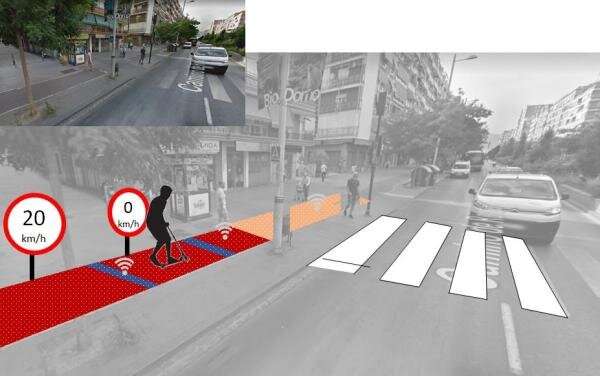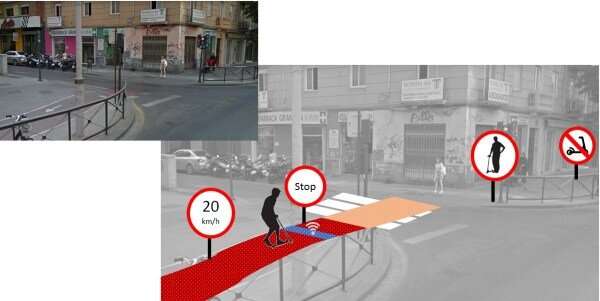Camino de Ronda (Granada). Bicycle-friendly roads specially modified with a “smart” surface that provides a speed-reduction warning.
Scientists from the University of Granada have used magnetic materials in "smart" asphalts that modify their properties in the presence of external magnetic fields. This work—part of the wider research field of "smart cities"—would enable roads to signal to scooters when to slow down, for example, or could automatically cut off the electric motor or engine in case of danger.
Scientists from the University of Granada (UGR) have designed "smart" asphalts, made with magnetic materials, that significantly increase the safety of Personal Mobility Devices (PMDs), in particular electric scooters, in urban areas.
This study, which is part of the wider "smart cities" research field, would enable roads to signal to scooters when to slow down, for example, or could automatically cut off the electric motor or engine in case of danger. The researchers have also developed a prototype PMD designed to interact with the smart asphalt.
The close collaboration between researchers Fernando Moreno Navarro and María del Carmen Rubio Gámez, from the UGR's Building Engineering Laboratory (LabIC), and Guillermo Iglesias Salto, from the university's Department of Applied Physics has led to the application of magnetic materials in creating smart asphalts that modify their properties when they come into contact with external magnetic fields.
The aim is to create better infrastructures for citizens—from public transport to energy savings, sustainability, and overall efficiency. These UGR researchers have produced more than five joint scientific publications in high-impact journals and have secured two patents—on mechano-mutable asphalt (PCT/ES2014/071002) and pavement safety systems (P201631096). Now, with this current research, they have developed a further novel application that would address the major problem of widespread electric-scooter use in cities.
Camino de Ronda (Granada). Code-activated traffic light with automatic motor shutdown, leaving only the manual mode free
First fatal accidents with scooters
In large cities, the proliferation of PMDs, including electric scooters, demonstrates that existing infrastructures are not yet equipped to deal with such vehicles. The necessary regulation is still in its infancy (or non-existent), and the first fatal accidents associated with their use have already been reported.
Hence, both of these UGR research laboratories are working on innovative projects to deal with the challenges of "smart cities" or cities of the future. One such project focuses on developing "encoded roads", whereby different amounts of metallic material are aggregated beneath roads, pavements, and pedestrian crossings, among other areas of the city, so that a code can be generated to identify and link specific working instructions with PMDs (electric scooters) and their users.
These codes beneath the asphalt send real-time information to the PMD, indicating the necessary reduction in speed, in accordance with the zone the user is crossing at the time (or triggering motor/engine shutdown in some cases), for example.
Electric scooter prototype
This project is linked to the work of researcher Paulina Leiva Padilla of the European Training Network on Sustainable Multi-functional Automated Resilient Transport Infrastructures (SMARTI), which is funded by the European Horizon 2020 Programme as a Marie Skłodowska-Curie Action. The first PMD prototype, which interacts with these asphalt codes, was successfully presented at the 8th European Asphalt Technology Association (EATA) Conference in Granada (3–5 June 2019), which brought together industry experts and researchers of great international prestige from the Civil Engineering field.
The UGR researchers regard this latest achievement as the next step toward introducing smart roads, to assist the automotive industry in its development of autonomous vehicles.
More information: F. Moreno-Navarro et al. Encoded asphalt materials for the guidance of autonomous vehicles, Automation in Construction (2018). DOI: 10.1016/j.autcon.2018.12.004
Provided by University of Granada
























